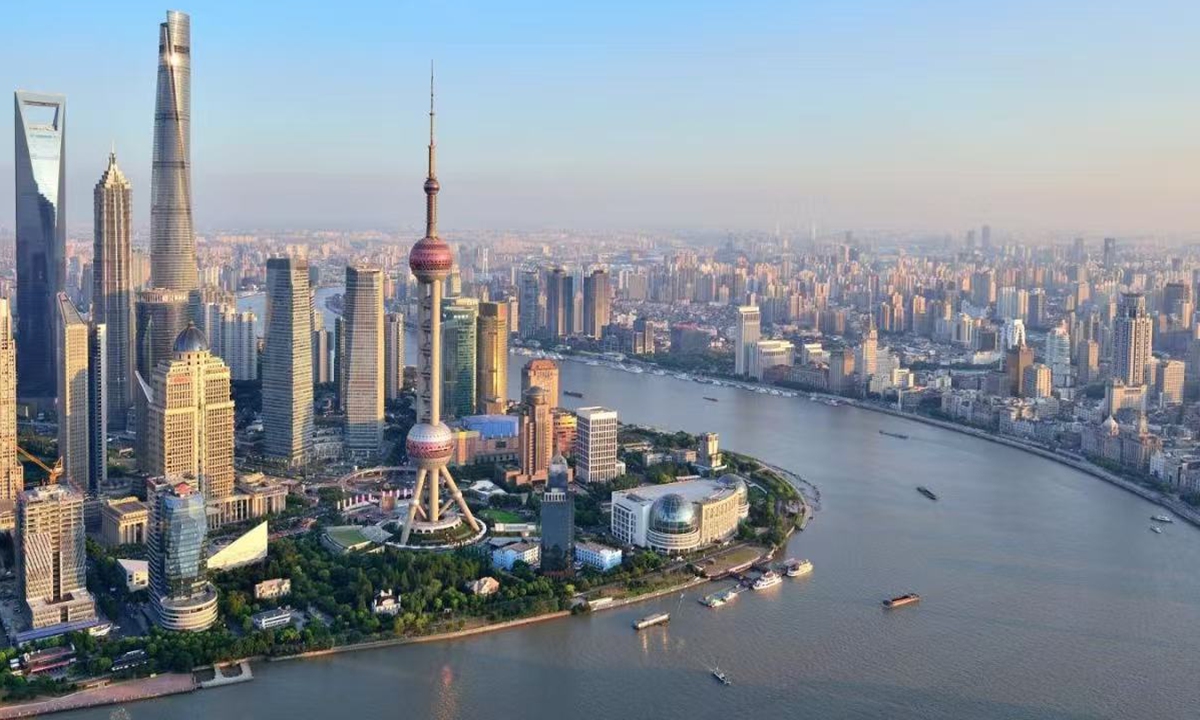
Lujiazui area in Shanghai Photo:Xinhua
As Chinese stocks had an extended bull run, with the Shanghai benchmark index recently hitting the highest level in a decade, multiple top global investors, including Allianz Global Investors Fund and Morgan Stanley, remain upbeat about China’s stock market in the coming months, betting on new opportunities amid the country’s macro policy support and the booming tech sector.
An analyst said that the stable uptrend of China’s stock market is expected to continue in the coming months thanks to the economy’s sustained recovery and inflows of long-term capital, and the strong capital market will in turn boost the development of innovative enterprises and give birth to more emerging industries.
The benchmark Shanghai Composite Index gained 1.45 percent to reach 3,825.76 points on Friday, its highest level since August 19, 2015, according to the Securities Times. The Shenzhen Component Index closed 2.07 percent higher at 12,166.06 points. The combined turnover of these two indices stood at 2.55 trillion yuan ($357.53 billion), surpassing the 2 trillion yuan mark for the eighth consecutive trading day, per media reports.
The stock market in the Hong Kong Special Administrative Region also rallied on Friday, with the benchmark Hang Seng Index up 0.93 percent to close at 25,339.14 points.
A-shares and H-shares in China are undergoing a synchronized value re-rating cycle, and there are investment opportunities in both markets, Cheng Yu, head of research at Allianz Global Investors Fund, wrote in a note sent to the Global Times on Sunday.
The third quarter marks a comprehensive acceleration in the fundamentals of China’s technology sector, and thus high-quality tech assets will deliver significant excess returns over the period, according to Cheng. Incorporating both A-shares and H-shares into an investment portfolio will not only comprehensively share dividends brought about by China’s economic growth and structural transformation but also maximize returns while reducing risks, he noted.
According to a report by Japan-based Nomura, reducing exposure to Indian shares while reallocating capital to stocks listed in regions including the Chinese mainland and Hong Kong has become a mainstream strategy among emerging market investors, Bloomberg reported on Thursday.
In recent months, northbound stock market trading has been active. The average daily trading volume stood at 148.5 billion yuan in June, but it rapidly increased to 202.4 billion yuan in July and to 265 billion yuan this month as of Friday, according to domestic financial information service provider Wind.
Meanwhile, foreign financial institutions, securities firms, private equity firms, and other institutions have been taking a close look at listed hard-tech companies in fields including integrated circuits, applied software and biotech this month, the China Securities Journal reported on Saturday.
“The current A-share rally is driven by a number of factors, including macro-outlook, liquidity, policy expectations and fund allocation, among others,” Morgan Stanley analysts led by Laura Wang, chief China equity strategist, wrote in a note sent to the Global Times recently.
The analysts continue to believe that A shares’ outperformance versus the offshore market will continue through the summer. “The government is accelerating the rollout of easing measures and incremental liquidity is being mobilized from bonds, savings and retail investors. As a result, the CSI 300 in the near term could trade toward our Bull case target at 4,700,” read the note.
“The improvement in the world’s second-largest economy has provided a solid foundation for the capital market’s strength,” Yang Delong, chief economist of the Shenzhen-based First Seafront Fund, told the Global Times on Sunday. Since mid-year, China’s macroeconomic policies have continued to strengthen, and the economy has demonstrated strong resilience and vitality despite external complexities and domestic extreme weather challenges,” Yang said, noting that more stabilization policies are expected to be implemented by the end of the year, further boosting economic growth.
According to data released by the National Bureau of Statistics in mid-August, the added value of industrial enterprises above the designated size grew by 5.7 percent year-on-year in July, maintaining relatively rapid growth. Nationwide retail sales grew by 3.7 percent year-on-year.
A meeting of the Communist Party of China Central Committee Political Bureau held on July 30 stressed that macro policies should be continuously strengthened and intensified in a timely manner, including implementing and refining a more proactive fiscal policy and a moderately loose monetary policy.
Since the meeting, Chinese authorities have taken swift action to bolster the economy. The People’s Bank of China, the central bank, on Friday announced that it will conduct a 600 billion yuan, one-year medium-term lending facility operation on Monday to maintain ample liquidity in the country’s banking system.
In addition, a State Council executive meeting on Friday called for efforts to strengthen overall coordination and refine implementation mechanisms of large-scale equipment upgrades and consumer goods trade-in programs to better leverage their role in boosting domestic demand.
“A robust capital market will empower technological innovation enterprises and catalyze the emergence of emerging industries, and therefore contribute to the development of new quality productive forces in China and drive its economic transformation and upgrade,” Yang said.






